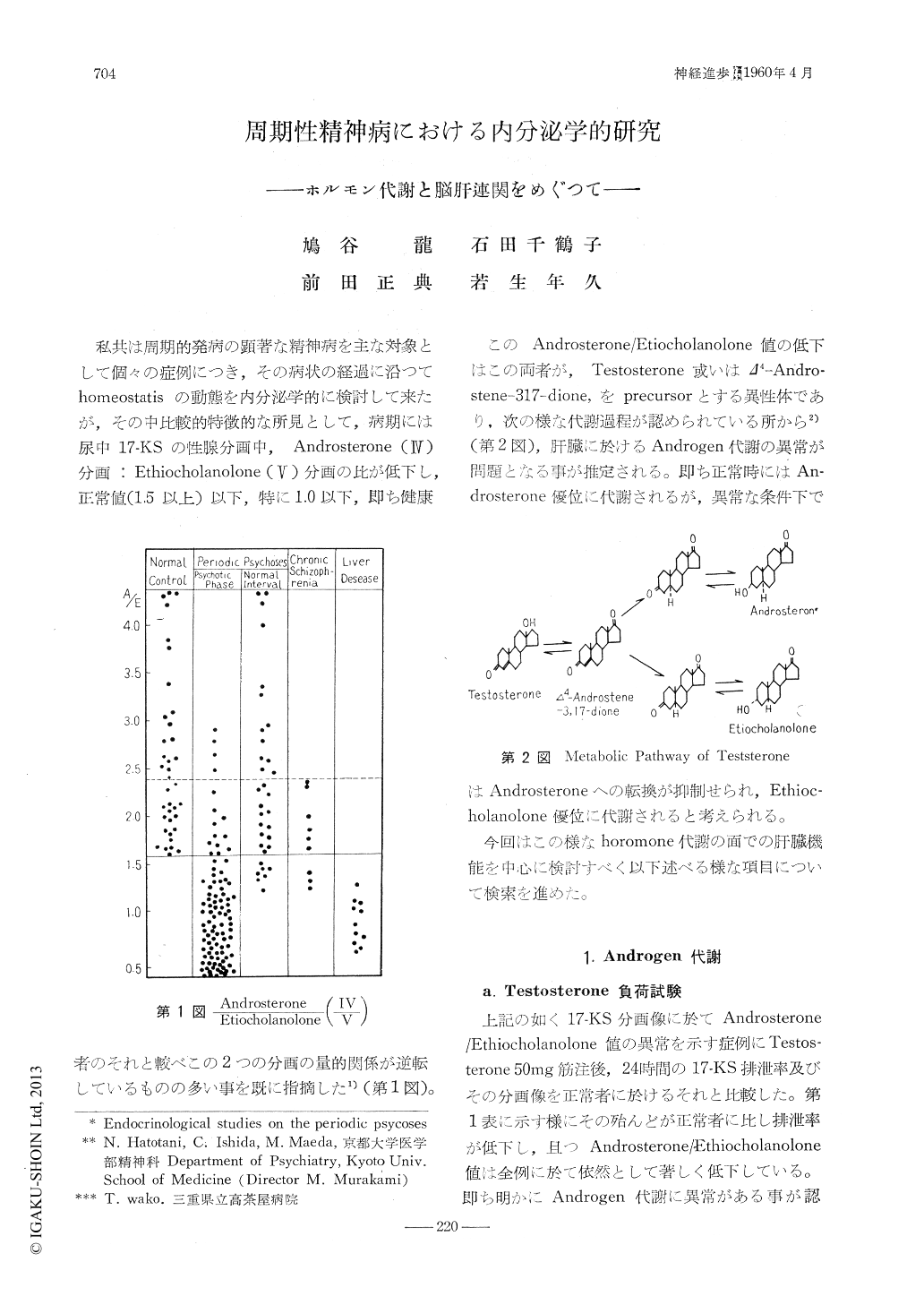Japanese
English
- 有料閲覧
- Abstract 文献概要
- 1ページ目 Look Inside
私共は周期的発病の顕著な精神病を主な対象として個々の症例につき,その病状の経過に沿つてhomeostatisの動態を内分泌学的に検討して来たが,その中比較的特徴的な所見として,病期には尿中17-KSの性腺分画中,Androsterone(IV)分画:Ethiocholanolone(V)分画の比が低下し,正常値(1.5以上)以下,特に1.0以下,即ち健康者のそれと較べこの2つの分画の量的関係が逆転しているものの多い事を既に指摘した1)(第1図)。
このAndrosterone/Etiocholanolone値の低下はこの両者が,Testosterone或いはΔ4-Androstene-317-dione,をprecursorとする異性体であり,次の様な代謝過程が認められている所から2)(第2図),肝臓に於けるAndrogen代謝の異常が問題となる事が推定される。即ち正常時にはAndrosterone優位に代謝されるが,異常な条件下ではAndrosteroneへの転換が抑制せられ,Ethiocholanolone優位に代謝されると考えられる。
The chromatographic fractions of urinary 17-KS of periodic psychotics showed various abnormalpatterns.
The most characteristic thing of them was thefact that androsterone was less than etiocholanolone. In view of the fact that androsterone andetiocholanolone have an isomeric structure andthat their commmon precursor is testosterone, onepossible explanation of this finding may be thattestosterone is metabolized dominantly to androsterone in normal adults but under abnormal conditions the pathway to etiocholanolone becomesdominant. Similar abnormal pattern was seenalso in liver diseases as well as in hypothalamicdisorders.
After administration of testosterone the patients, as compared to normal controls, showed low excretion rates of 17-KS with abnormal patternsmentioned above. In female periodic paychotics, pattern of estrogen excretion was irregular invarious fashions and the ratio between estrogenfractions was found to be abnormal as was observed in liver diseases. Furthermore, estrogenclearance test showed abnormal pattern also inthese patients.
Finally, we have examined 17-KS patterns inthe socalled LSD experimental psychoses. Itwas found in all cases that during the first 24hours after administration of LSD-25 androsterone was markedly reduced and the pattern of fractions was abnormal in a similar way as wasobserved in periodic psychoses, but it returned toa normal state after 48 to 72 hours. As a conclusion from findings mentioned above, we would like to say that the abnormal patterns of androgen and estrogen fractions found in periodic psychotics will be explicable in terms of adisorder of the liver and also that of the hypothalamic function.
The mutual relationship between the liver andhypothalamus thus comes into question. However, it is considered that the disorder of the liver isnot the primary factor on the development of periodic psycoses but it is only an aspect of thechain of homeostatic breakdowns.
(Author's abstract)

Copyright © 1960, Igaku-Shoin Ltd. All rights reserved.


